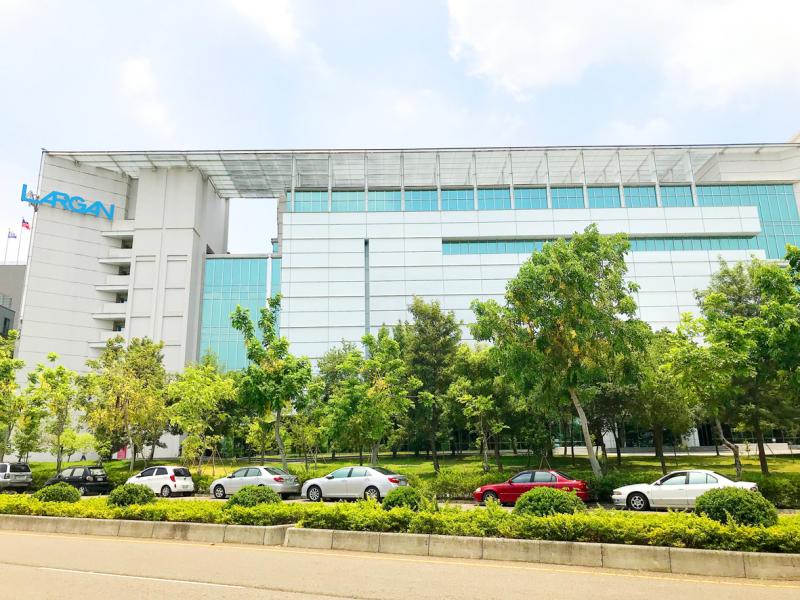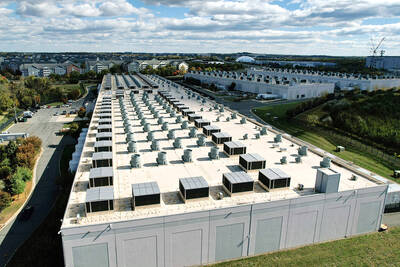Largan Precision Co (大立光), the nation’s leading handset camera lens manufacturer, yesterday posted a 25.77 percent quarterly decline in net profit for last quarter to NT$4.99 billion (US$168.7 million), reaching its weakest level in nine quarters due to sagging demand.
Largan in the first quarter made NT$6.72 billion in net profit, the company said.
Earnings per share in the last quarter dropped to NT$37.19 from NT$50.1 in the previous quarter.

Photo: Chen Mei-ying, Taipei Times
The Taichung-based company yesterday also booked a nonoperating loss of NT$536.42 million for the last quarter, reversing a nonoperating income of NT$414.64 million in the first quarter.
Gross margin fell slightly to 68.63 percent, compared with 69.8 percent in the first quarter, the company’s financial statement showed.
In an investors’ conference, Largan CEO Adam Lin (林恩平) gave conservative projections.
“I think July and August are going to be about the same as June,” Lin said.
Largan last month posted monthly revenue growth of 6.98 percent to NT$4.14 billion, ending two straight months of declines.
Regarding the company’s revenue outlook for September and October, Lin said: “I cannot see that far.”
Lin blamed softening demand rather than market share loss to competitors for the drop, saying: “Demand is down. Demand for high-specification products, especially” was down, Lin said.
When asked about the prospects of Chinese competition increasing next year, Lin said: “I do not know.”
Institutional investors in the conference said they were curious about the company’s plans for new continuous or fixed optical zoom lens products for smartphone cameras.
Lin said it would be a daunting task from a technical perspective to create the lenses with the limiting form factor of mobile phones and to achieve the high level of precision required to make the lens.
“Everybody wants this, but it is just hard,” Lin said.
The company’s freeform lens technology is in the testing phase, he said, adding that he is optimistic that by the end of the year, Largan would begin shipping the product.
Largan would keep pace with the research and development of new products, “but it is up to the clients whether they get designed” into new products, Lin said.

The demise of the coal industry left the US’ Appalachian region in tatters, with lost jobs, spoiled water and countless kilometers of abandoned underground mines. Now entrepreneurs are eyeing the rural region with ambitious visions to rebuild its economy by converting old mines into solar power systems and data centers that could help fuel the increasing power demands of the artificial intelligence (AI) boom. One such project is underway by a non-profit team calling itself Energy DELTA (Discovery, Education, Learning and Technology Accelerator) Lab, which is looking to develop energy sources on about 26,305 hectares of old coal land in

Taiwan’s exports soared 56 percent year-on-year to an all-time high of US$64.05 billion last month, propelled by surging global demand for artificial intelligence (AI), high-performance computing and cloud service infrastructure, the Ministry of Finance said yesterday. Department of Statistics Director-General Beatrice Tsai (蔡美娜) called the figure an unexpected upside surprise, citing a wave of technology orders from overseas customers alongside the usual year-end shopping season for technology products. Growth is likely to remain strong this month, she said, projecting a 40 percent to 45 percent expansion on an annual basis. The outperformance could prompt the Directorate-General of Budget, Accounting and

Netflix on Friday faced fierce criticism over its blockbuster deal to acquire Warner Bros Discovery. The streaming giant is already viewed as a pariah in some Hollywood circles, largely due to its reluctance to release content in theaters and its disruption of traditional industry practices. As Netflix emerged as the likely winning bidder for Warner Bros — the studio behind Casablanca, the Harry Potter movies and Friends — Hollywood’s elite launched an aggressive campaign against the acquisition. Titanic director James Cameron called the buyout a “disaster,” while a group of prominent producers are lobbying US Congress to oppose the deal,

Two Chinese chipmakers are attracting strong retail investor demand, buoyed by industry peer Moore Threads Technology Co’s (摩爾線程) stellar debut. The retail portion of MetaX Integrated Circuits (Shanghai) Co’s (上海沐曦) upcoming initial public offering (IPO) was 2,986 times oversubscribed on Friday, according to a filing. Meanwhile, Beijing Onmicro Electronics Co (北京昂瑞微), which makes radio frequency chips, was 2,899 times oversubscribed on Friday, its filing showed. The bids coincided with Moore Threads’ trading debut, which surged 425 percent on Friday after raising 8 billion yuan (US$1.13 billion) on bets that the company could emerge as a viable local competitor to Nvidia